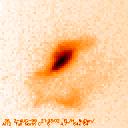
The Sun finally came through with an "X-class flare" on August 2, the first this year. There had been 1, 3, and 10 such flares in 1996, 1997, and 1998 respectively, as the solar cycle built up towards its maximum - about now! So by any scheme of extrapolation, we would have expected more than one X-flare by now in 1999. These numbers may be a bit inaccurate, because I haven't checked the database thoroughly, but any way you cut it one would have expected more than one X-class flare in the first seven months of 1999. So how do we explain this astonishing shortfall?
First let's define X-flares. These are not related to X-files. Instead "X" is an arbitrary shorthand for a flare that produces more than 0.1 ergs/cm^2 s in soft X-radiation, as defined by the GOES sensors, at the vicinity of the Earth. This is about 100 billionths (10^-7) of the total solar luminosity, which might be a more rational scale. For those of you who have always been mystified by the odious "C, M, X" classification, here it is redefined in billionths:
| Name | Billionths | Log Power (cgs) |
| X | 100 | 26.5 |
| M | 10 | 25.5 |
| C | 1 | 24.5 |
| B | .1 | 23.5 |
An even more rational way to redefine this scale would be in the logarithm of the power in ergs/sec, say - rumor has it that the Russian earthquake scale, not the Richter scale, has this easily understandable interpretation! But we digress. The distribution of flare energies, ie how many flares per unit peak energy, falls as a flat negative power law. Thus fewer large flares happen than small ones. But this negative power law has an index in the range 1.5-1.8, and it extends down from the flare range into the microflare (10 trillionths) and nanoflare (10 quadrillionths - see how helpful this new nomenclature is?). Because it is so flat, the total energy devoted by the Sun to flares is "open-ended" - the single largest flare dominates the total flare energy. Interesting? Thus Lingenfelter and Hudson noted some time ago that there really needed to be an upper cutoff in the power-law distribution. In other words, the flare energy distribution would steepen above some threshold energy. Normally this threshold energy can be quite high - flares of magnitude X30 (3 millionths) are not unknown. But during early 1999, for reasons known to the Sun but not to us, this threshold clearly had dropped by a large factor. So, this flare was interesting as an exception testing some sort of rule! The "astonishing shortfall" alluded to above can also be seen in the ratio of numbers of M and X flares
| Year | M's | X's |
| 1996 | 3 | 1 |
| 1997 | 21 | 3 |
| 1998 | 94 | 10 |
| 1999 (through July) | 83 | Zero! |
The "zero" entry corresponds to an expectation of 13-26 X flares, depending upon the power-law index of the distribution. One swallow does not make a summer, but this "a posteriori" statistics is pretty convincing for the case that the cutoff flare energy was lower - a factor of 100 or so - than it is normally.
The flare itself was dull because it had no really exciting ejections. Ace flare scholar N. Nitta announced by e-mail that "In this sense this event is uninteresting to me," in fact - but mainly because SXT missed the impulsive phase, when eruptions occur. But this flare did not have an eruptive morphology:
This is a Yohkoh SXT high-resolution image (2.5" pixels) from the peak of the flare, showing that it's a compact event rather than a giant arcade. Correspondingly, the associated CME (if any) was a minor affair, but the details not known at the time of writing unfortunately.
The image below shows that an arcade did not develop:
These are registered (rotated) Al.1 images, the later one with 5" pixels, scaled to uniform brightness. The absence of a long-lived arcade is clear enough.
From the hard X-ray point of view, however, things get a bit more interesting. Here's a Yohkoh HXT four-channel overview of the time profile:
which reveals a striking "superhot" signature, recognized by the gradual smooth decay with a soft spectrum. However the spectrum is not thermal! Compare now with the BATSE observations:
Here, astonishingly, we see the gradual decay not only in the BATSE low-energy channel, 25-50 keV, but also in the high-energy channel, 50-100 keV. If from a Maxwellian ("thermal") plasma, these counts could only be produced by "temperatures" far in excess of any theoretically easy relaxation process. More likely, we are seeing the gradual evolution of the hard X-ray bremsstrahlung spectrum from thermal to non-thermal in a weaker phase of energy release following the impulsive phase of the flare. Check out the comparison between HXT and BATSE:
in particular in comparison with last week's nugget, which made a comparison of the same two channels for a very different kind of flare. Here the two light curves diverge, implying different responses for a "superhot" flare compared with a flare having an ordinary non-thermal spectrum.
August 6, 1999